Business-Level Strategy Report on Namoi Cotton Company, Australia
VerifiedAdded on 2023/06/04
|9
|2076
|166
Report
AI Summary
This report analyzes Namoi Cotton's business-level strategies, including integrated cost leadership, focused cost leadership, and differentiation. It examines how the company leverages these strategies to achieve a competitive advantage in the Australian cotton industry. The integrated cost leadership strategy focuses on managing various costs using tools like the Balanced Scorecard. The focused cost leadership strategy aims to achieve lower manufacturing costs without sacrificing quality. The differentiation strategy emphasizes product uniqueness and marketing know-how to satisfy customer expectations. The report also discusses opportunities for improving the value chain and the importance of considering external factors and market dynamics when implementing these strategies. This document is available on Desklib, a platform offering a wide range of study resources including past papers and solved assignments to support students' learning needs.
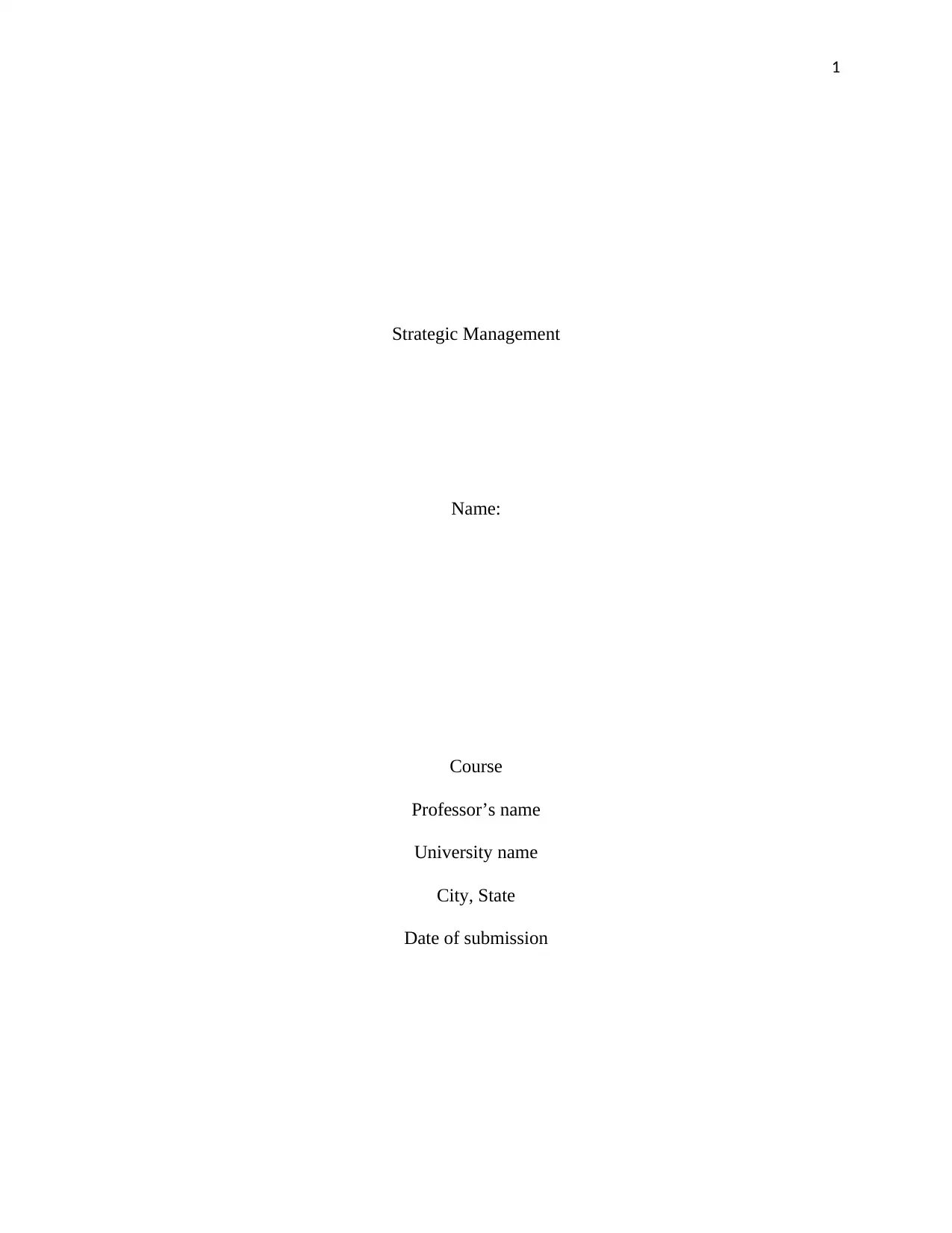
1
Strategic Management
Name:
Course
Professor’s name
University name
City, State
Date of submission
Strategic Management
Name:
Course
Professor’s name
University name
City, State
Date of submission
Paraphrase This Document
Need a fresh take? Get an instant paraphrase of this document with our AI Paraphraser
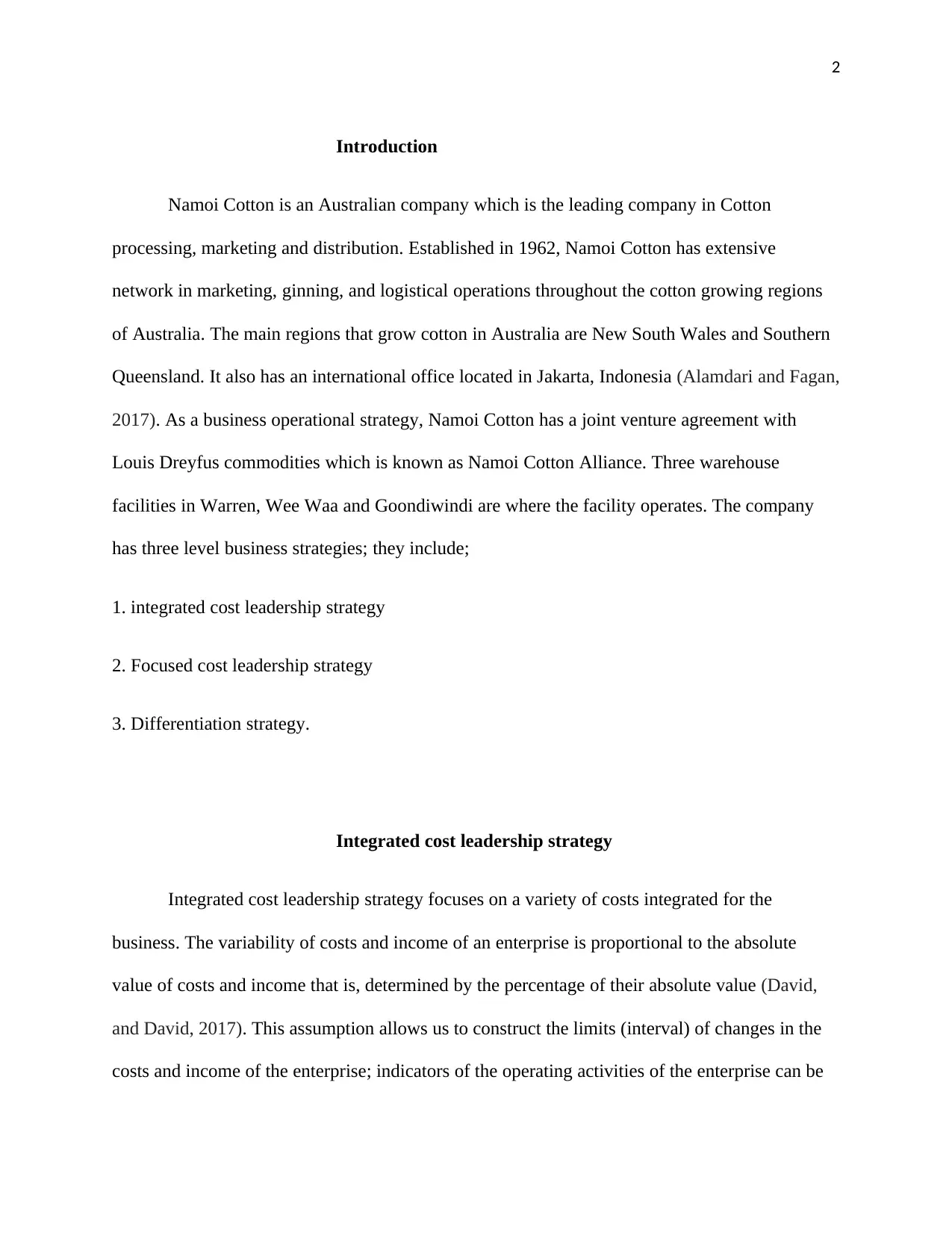
2
Introduction
Namoi Cotton is an Australian company which is the leading company in Cotton
processing, marketing and distribution. Established in 1962, Namoi Cotton has extensive
network in marketing, ginning, and logistical operations throughout the cotton growing regions
of Australia. The main regions that grow cotton in Australia are New South Wales and Southern
Queensland. It also has an international office located in Jakarta, Indonesia (Alamdari and Fagan,
2017). As a business operational strategy, Namoi Cotton has a joint venture agreement with
Louis Dreyfus commodities which is known as Namoi Cotton Alliance. Three warehouse
facilities in Warren, Wee Waa and Goondiwindi are where the facility operates. The company
has three level business strategies; they include;
1. integrated cost leadership strategy
2. Focused cost leadership strategy
3. Differentiation strategy.
Integrated cost leadership strategy
Integrated cost leadership strategy focuses on a variety of costs integrated for the
business. The variability of costs and income of an enterprise is proportional to the absolute
value of costs and income that is, determined by the percentage of their absolute value (David,
and David, 2017). This assumption allows us to construct the limits (interval) of changes in the
costs and income of the enterprise; indicators of the operating activities of the enterprise can be
Introduction
Namoi Cotton is an Australian company which is the leading company in Cotton
processing, marketing and distribution. Established in 1962, Namoi Cotton has extensive
network in marketing, ginning, and logistical operations throughout the cotton growing regions
of Australia. The main regions that grow cotton in Australia are New South Wales and Southern
Queensland. It also has an international office located in Jakarta, Indonesia (Alamdari and Fagan,
2017). As a business operational strategy, Namoi Cotton has a joint venture agreement with
Louis Dreyfus commodities which is known as Namoi Cotton Alliance. Three warehouse
facilities in Warren, Wee Waa and Goondiwindi are where the facility operates. The company
has three level business strategies; they include;
1. integrated cost leadership strategy
2. Focused cost leadership strategy
3. Differentiation strategy.
Integrated cost leadership strategy
Integrated cost leadership strategy focuses on a variety of costs integrated for the
business. The variability of costs and income of an enterprise is proportional to the absolute
value of costs and income that is, determined by the percentage of their absolute value (David,
and David, 2017). This assumption allows us to construct the limits (interval) of changes in the
costs and income of the enterprise; indicators of the operating activities of the enterprise can be
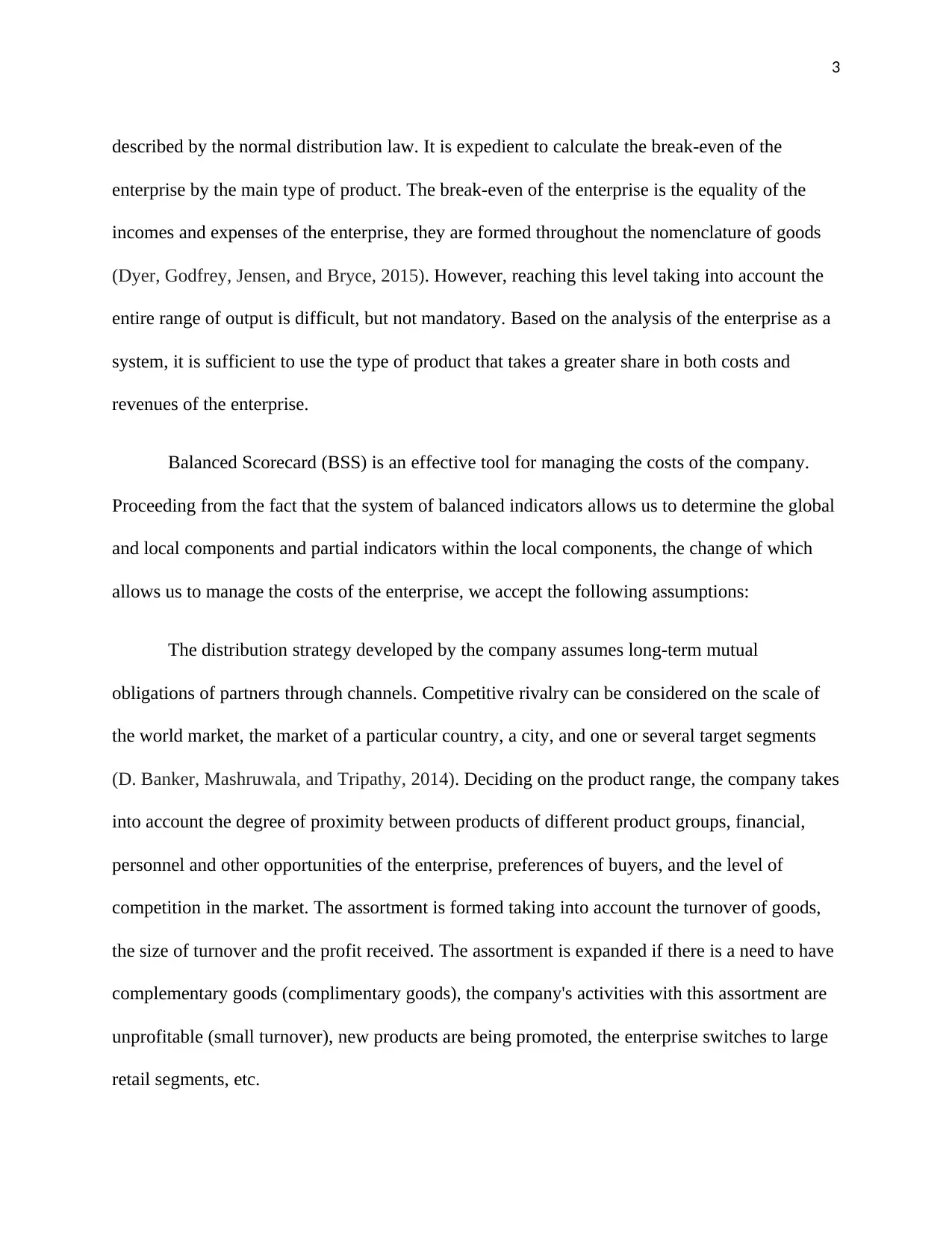
3
described by the normal distribution law. It is expedient to calculate the break-even of the
enterprise by the main type of product. The break-even of the enterprise is the equality of the
incomes and expenses of the enterprise, they are formed throughout the nomenclature of goods
(Dyer, Godfrey, Jensen, and Bryce, 2015). However, reaching this level taking into account the
entire range of output is difficult, but not mandatory. Based on the analysis of the enterprise as a
system, it is sufficient to use the type of product that takes a greater share in both costs and
revenues of the enterprise.
Balanced Scorecard (BSS) is an effective tool for managing the costs of the company.
Proceeding from the fact that the system of balanced indicators allows us to determine the global
and local components and partial indicators within the local components, the change of which
allows us to manage the costs of the enterprise, we accept the following assumptions:
The distribution strategy developed by the company assumes long-term mutual
obligations of partners through channels. Competitive rivalry can be considered on the scale of
the world market, the market of a particular country, a city, and one or several target segments
(D. Banker, Mashruwala, and Tripathy, 2014). Deciding on the product range, the company takes
into account the degree of proximity between products of different product groups, financial,
personnel and other opportunities of the enterprise, preferences of buyers, and the level of
competition in the market. The assortment is formed taking into account the turnover of goods,
the size of turnover and the profit received. The assortment is expanded if there is a need to have
complementary goods (complimentary goods), the company's activities with this assortment are
unprofitable (small turnover), new products are being promoted, the enterprise switches to large
retail segments, etc.
described by the normal distribution law. It is expedient to calculate the break-even of the
enterprise by the main type of product. The break-even of the enterprise is the equality of the
incomes and expenses of the enterprise, they are formed throughout the nomenclature of goods
(Dyer, Godfrey, Jensen, and Bryce, 2015). However, reaching this level taking into account the
entire range of output is difficult, but not mandatory. Based on the analysis of the enterprise as a
system, it is sufficient to use the type of product that takes a greater share in both costs and
revenues of the enterprise.
Balanced Scorecard (BSS) is an effective tool for managing the costs of the company.
Proceeding from the fact that the system of balanced indicators allows us to determine the global
and local components and partial indicators within the local components, the change of which
allows us to manage the costs of the enterprise, we accept the following assumptions:
The distribution strategy developed by the company assumes long-term mutual
obligations of partners through channels. Competitive rivalry can be considered on the scale of
the world market, the market of a particular country, a city, and one or several target segments
(D. Banker, Mashruwala, and Tripathy, 2014). Deciding on the product range, the company takes
into account the degree of proximity between products of different product groups, financial,
personnel and other opportunities of the enterprise, preferences of buyers, and the level of
competition in the market. The assortment is formed taking into account the turnover of goods,
the size of turnover and the profit received. The assortment is expanded if there is a need to have
complementary goods (complimentary goods), the company's activities with this assortment are
unprofitable (small turnover), new products are being promoted, the enterprise switches to large
retail segments, etc.
⊘ This is a preview!⊘
Do you want full access?
Subscribe today to unlock all pages.

Trusted by 1+ million students worldwide
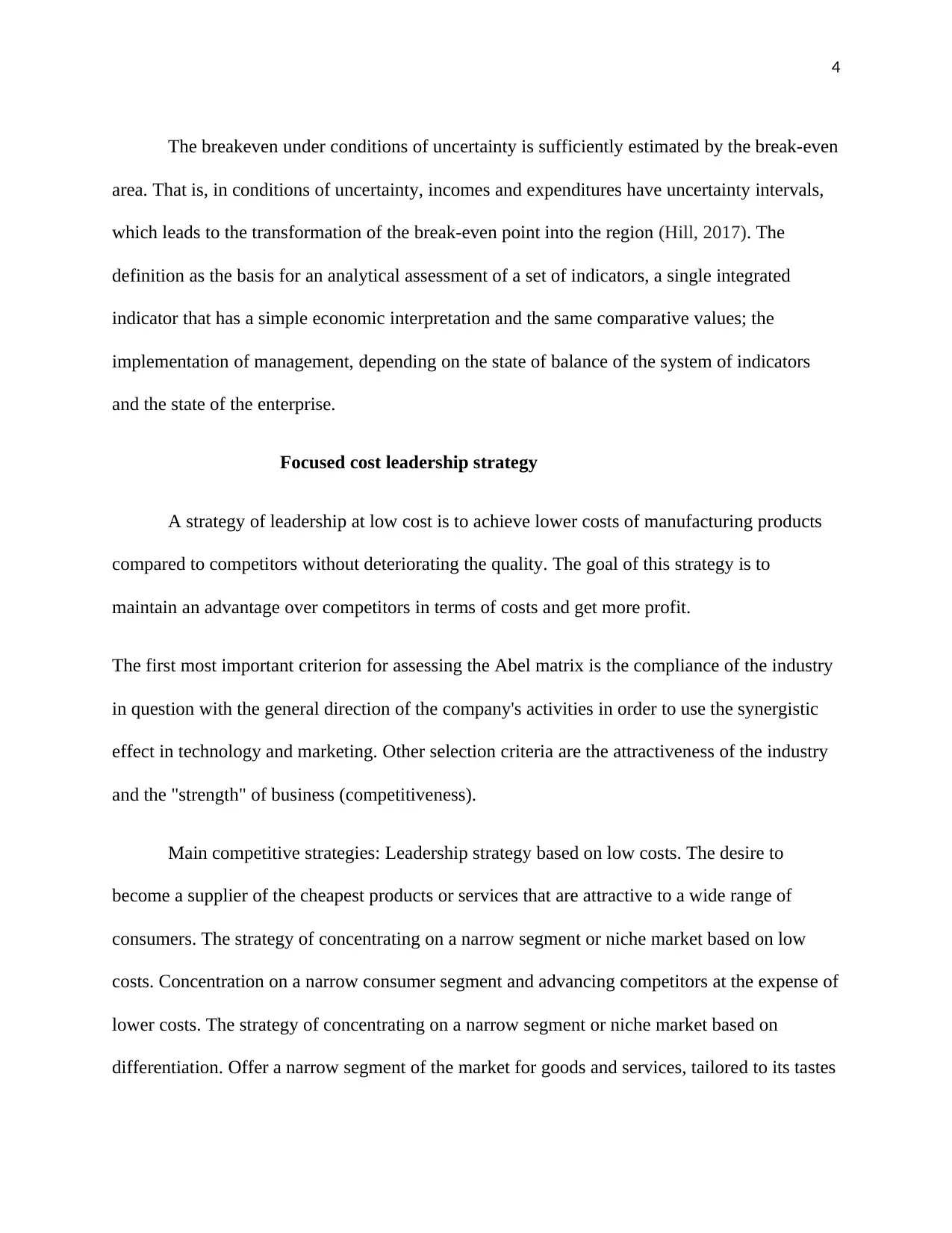
4
The breakeven under conditions of uncertainty is sufficiently estimated by the break-even
area. That is, in conditions of uncertainty, incomes and expenditures have uncertainty intervals,
which leads to the transformation of the break-even point into the region (Hill, 2017). The
definition as the basis for an analytical assessment of a set of indicators, a single integrated
indicator that has a simple economic interpretation and the same comparative values; the
implementation of management, depending on the state of balance of the system of indicators
and the state of the enterprise.
Focused cost leadership strategy
A strategy of leadership at low cost is to achieve lower costs of manufacturing products
compared to competitors without deteriorating the quality. The goal of this strategy is to
maintain an advantage over competitors in terms of costs and get more profit.
The first most important criterion for assessing the Abel matrix is the compliance of the industry
in question with the general direction of the company's activities in order to use the synergistic
effect in technology and marketing. Other selection criteria are the attractiveness of the industry
and the "strength" of business (competitiveness).
Main competitive strategies: Leadership strategy based on low costs. The desire to
become a supplier of the cheapest products or services that are attractive to a wide range of
consumers. The strategy of concentrating on a narrow segment or niche market based on low
costs. Concentration on a narrow consumer segment and advancing competitors at the expense of
lower costs. The strategy of concentrating on a narrow segment or niche market based on
differentiation. Offer a narrow segment of the market for goods and services, tailored to its tastes
The breakeven under conditions of uncertainty is sufficiently estimated by the break-even
area. That is, in conditions of uncertainty, incomes and expenditures have uncertainty intervals,
which leads to the transformation of the break-even point into the region (Hill, 2017). The
definition as the basis for an analytical assessment of a set of indicators, a single integrated
indicator that has a simple economic interpretation and the same comparative values; the
implementation of management, depending on the state of balance of the system of indicators
and the state of the enterprise.
Focused cost leadership strategy
A strategy of leadership at low cost is to achieve lower costs of manufacturing products
compared to competitors without deteriorating the quality. The goal of this strategy is to
maintain an advantage over competitors in terms of costs and get more profit.
The first most important criterion for assessing the Abel matrix is the compliance of the industry
in question with the general direction of the company's activities in order to use the synergistic
effect in technology and marketing. Other selection criteria are the attractiveness of the industry
and the "strength" of business (competitiveness).
Main competitive strategies: Leadership strategy based on low costs. The desire to
become a supplier of the cheapest products or services that are attractive to a wide range of
consumers. The strategy of concentrating on a narrow segment or niche market based on low
costs. Concentration on a narrow consumer segment and advancing competitors at the expense of
lower costs. The strategy of concentrating on a narrow segment or niche market based on
differentiation. Offer a narrow segment of the market for goods and services, tailored to its tastes
Paraphrase This Document
Need a fresh take? Get an instant paraphrase of this document with our AI Paraphraser
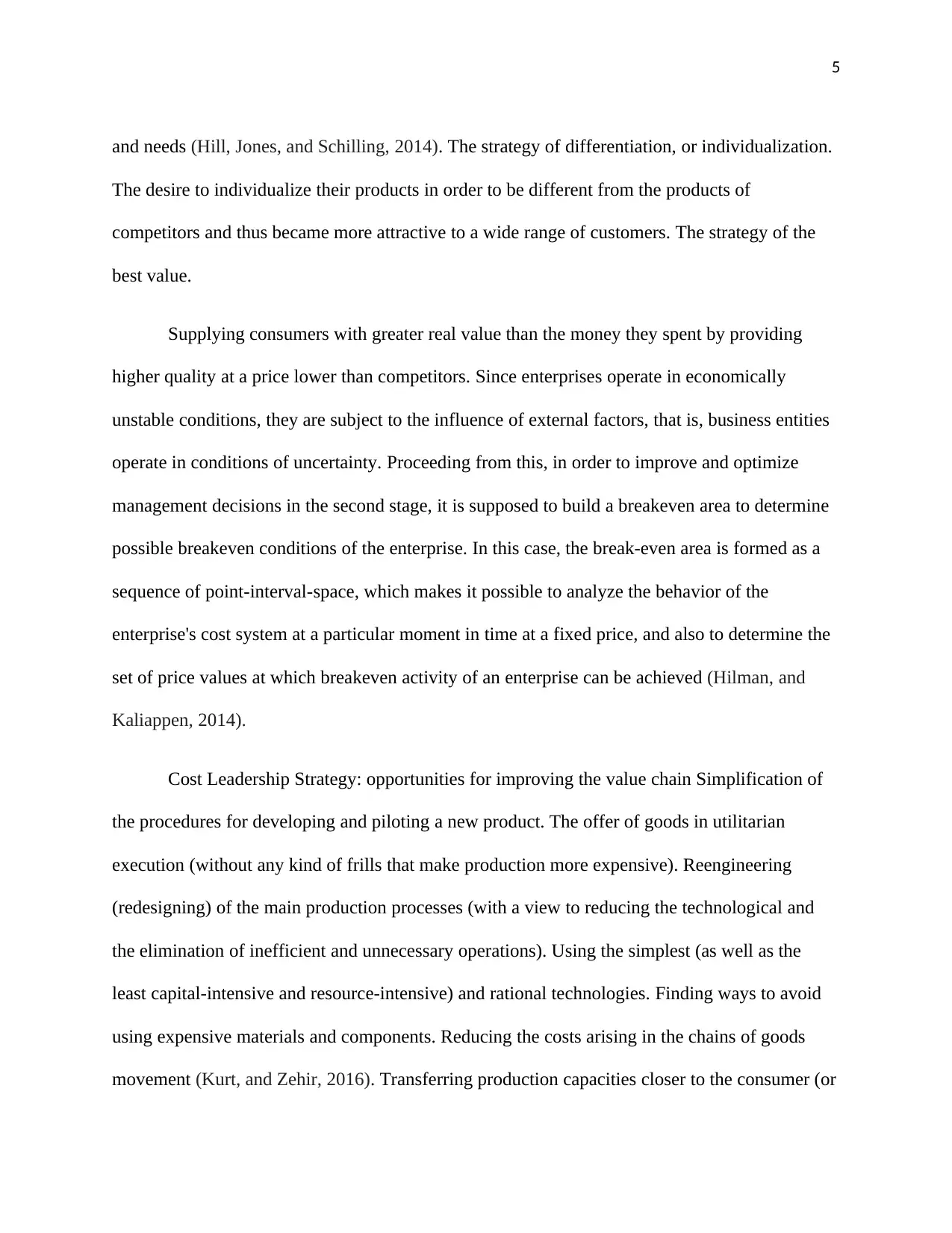
5
and needs (Hill, Jones, and Schilling, 2014). The strategy of differentiation, or individualization.
The desire to individualize their products in order to be different from the products of
competitors and thus became more attractive to a wide range of customers. The strategy of the
best value.
Supplying consumers with greater real value than the money they spent by providing
higher quality at a price lower than competitors. Since enterprises operate in economically
unstable conditions, they are subject to the influence of external factors, that is, business entities
operate in conditions of uncertainty. Proceeding from this, in order to improve and optimize
management decisions in the second stage, it is supposed to build a breakeven area to determine
possible breakeven conditions of the enterprise. In this case, the break-even area is formed as a
sequence of point-interval-space, which makes it possible to analyze the behavior of the
enterprise's cost system at a particular moment in time at a fixed price, and also to determine the
set of price values at which breakeven activity of an enterprise can be achieved (Hilman, and
Kaliappen, 2014).
Cost Leadership Strategy: opportunities for improving the value chain Simplification of
the procedures for developing and piloting a new product. The offer of goods in utilitarian
execution (without any kind of frills that make production more expensive). Reengineering
(redesigning) of the main production processes (with a view to reducing the technological and
the elimination of inefficient and unnecessary operations). Using the simplest (as well as the
least capital-intensive and resource-intensive) and rational technologies. Finding ways to avoid
using expensive materials and components. Reducing the costs arising in the chains of goods
movement (Kurt, and Zehir, 2016). Transferring production capacities closer to the consumer (or
and needs (Hill, Jones, and Schilling, 2014). The strategy of differentiation, or individualization.
The desire to individualize their products in order to be different from the products of
competitors and thus became more attractive to a wide range of customers. The strategy of the
best value.
Supplying consumers with greater real value than the money they spent by providing
higher quality at a price lower than competitors. Since enterprises operate in economically
unstable conditions, they are subject to the influence of external factors, that is, business entities
operate in conditions of uncertainty. Proceeding from this, in order to improve and optimize
management decisions in the second stage, it is supposed to build a breakeven area to determine
possible breakeven conditions of the enterprise. In this case, the break-even area is formed as a
sequence of point-interval-space, which makes it possible to analyze the behavior of the
enterprise's cost system at a particular moment in time at a fixed price, and also to determine the
set of price values at which breakeven activity of an enterprise can be achieved (Hilman, and
Kaliappen, 2014).
Cost Leadership Strategy: opportunities for improving the value chain Simplification of
the procedures for developing and piloting a new product. The offer of goods in utilitarian
execution (without any kind of frills that make production more expensive). Reengineering
(redesigning) of the main production processes (with a view to reducing the technological and
the elimination of inefficient and unnecessary operations). Using the simplest (as well as the
least capital-intensive and resource-intensive) and rational technologies. Finding ways to avoid
using expensive materials and components. Reducing the costs arising in the chains of goods
movement (Kurt, and Zehir, 2016). Transferring production capacities closer to the consumer (or

6
to the supplier) in order to reduce transportation costs. To achieve a higher level of integration
"forward" and "back" in comparison with competitors.
Focusing on a limited assortment of goods and services with a view to prioritizing the
satisfaction of specific but significant needs for customers and eliminating the costs associated
with producing a wide range of products. In the case of choosing this strategy, the company can
set itself the following strategic objectives: Suppliers with low prices constantly high quality
Quick and easy purchase Attractive choice among the goals that lead to the implementation of
this strategy: Reduction of the purchase cost reduction in liters .The availability of the optimal
assortment. Reduction of the delivery terms.
Differentiation strategy
Give a brief description of the differentiation strategy and what are the competitive
strategies for it Differentiation strategies are strategies resulting from an external competitive
advantage that is based on the marketing know-how of the firm, its superiority in identifying and
satisfying the expectations of customers who are dissatisfied with existing products. In the midst
of marketers, there is even such an expression: "The more significant the difference between a
product and its competitors, the more justified is every additional zero in its price tag." With
differentiation, the main emphasis is on the uniqueness of the product. But it is necessary to
differentiate the product not only with the help of its distinctive quality. For these purposes, it is
necessary to use other strategies, so that the buyer is convinced of the features of the product so
much that he is ready to pay for it the price higher than the similar goods from competitors
(Robson, 2015).
to the supplier) in order to reduce transportation costs. To achieve a higher level of integration
"forward" and "back" in comparison with competitors.
Focusing on a limited assortment of goods and services with a view to prioritizing the
satisfaction of specific but significant needs for customers and eliminating the costs associated
with producing a wide range of products. In the case of choosing this strategy, the company can
set itself the following strategic objectives: Suppliers with low prices constantly high quality
Quick and easy purchase Attractive choice among the goals that lead to the implementation of
this strategy: Reduction of the purchase cost reduction in liters .The availability of the optimal
assortment. Reduction of the delivery terms.
Differentiation strategy
Give a brief description of the differentiation strategy and what are the competitive
strategies for it Differentiation strategies are strategies resulting from an external competitive
advantage that is based on the marketing know-how of the firm, its superiority in identifying and
satisfying the expectations of customers who are dissatisfied with existing products. In the midst
of marketers, there is even such an expression: "The more significant the difference between a
product and its competitors, the more justified is every additional zero in its price tag." With
differentiation, the main emphasis is on the uniqueness of the product. But it is necessary to
differentiate the product not only with the help of its distinctive quality. For these purposes, it is
necessary to use other strategies, so that the buyer is convinced of the features of the product so
much that he is ready to pay for it the price higher than the similar goods from competitors
(Robson, 2015).
⊘ This is a preview!⊘
Do you want full access?
Subscribe today to unlock all pages.

Trusted by 1+ million students worldwide
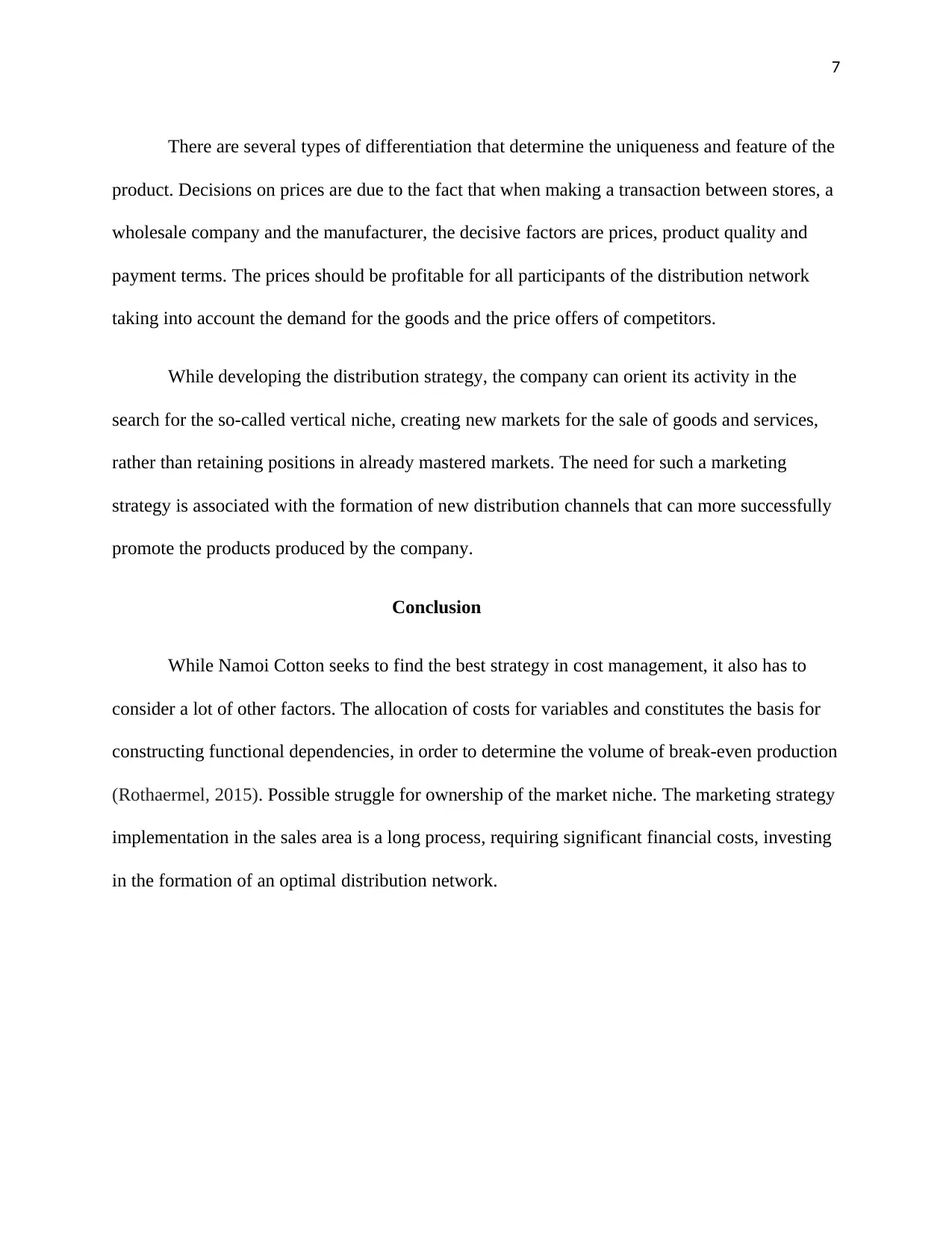
7
There are several types of differentiation that determine the uniqueness and feature of the
product. Decisions on prices are due to the fact that when making a transaction between stores, a
wholesale company and the manufacturer, the decisive factors are prices, product quality and
payment terms. The prices should be profitable for all participants of the distribution network
taking into account the demand for the goods and the price offers of competitors.
While developing the distribution strategy, the company can orient its activity in the
search for the so-called vertical niche, creating new markets for the sale of goods and services,
rather than retaining positions in already mastered markets. The need for such a marketing
strategy is associated with the formation of new distribution channels that can more successfully
promote the products produced by the company.
Conclusion
While Namoi Cotton seeks to find the best strategy in cost management, it also has to
consider a lot of other factors. The allocation of costs for variables and constitutes the basis for
constructing functional dependencies, in order to determine the volume of break-even production
(Rothaermel, 2015). Possible struggle for ownership of the market niche. The marketing strategy
implementation in the sales area is a long process, requiring significant financial costs, investing
in the formation of an optimal distribution network.
There are several types of differentiation that determine the uniqueness and feature of the
product. Decisions on prices are due to the fact that when making a transaction between stores, a
wholesale company and the manufacturer, the decisive factors are prices, product quality and
payment terms. The prices should be profitable for all participants of the distribution network
taking into account the demand for the goods and the price offers of competitors.
While developing the distribution strategy, the company can orient its activity in the
search for the so-called vertical niche, creating new markets for the sale of goods and services,
rather than retaining positions in already mastered markets. The need for such a marketing
strategy is associated with the formation of new distribution channels that can more successfully
promote the products produced by the company.
Conclusion
While Namoi Cotton seeks to find the best strategy in cost management, it also has to
consider a lot of other factors. The allocation of costs for variables and constitutes the basis for
constructing functional dependencies, in order to determine the volume of break-even production
(Rothaermel, 2015). Possible struggle for ownership of the market niche. The marketing strategy
implementation in the sales area is a long process, requiring significant financial costs, investing
in the formation of an optimal distribution network.
Paraphrase This Document
Need a fresh take? Get an instant paraphrase of this document with our AI Paraphraser
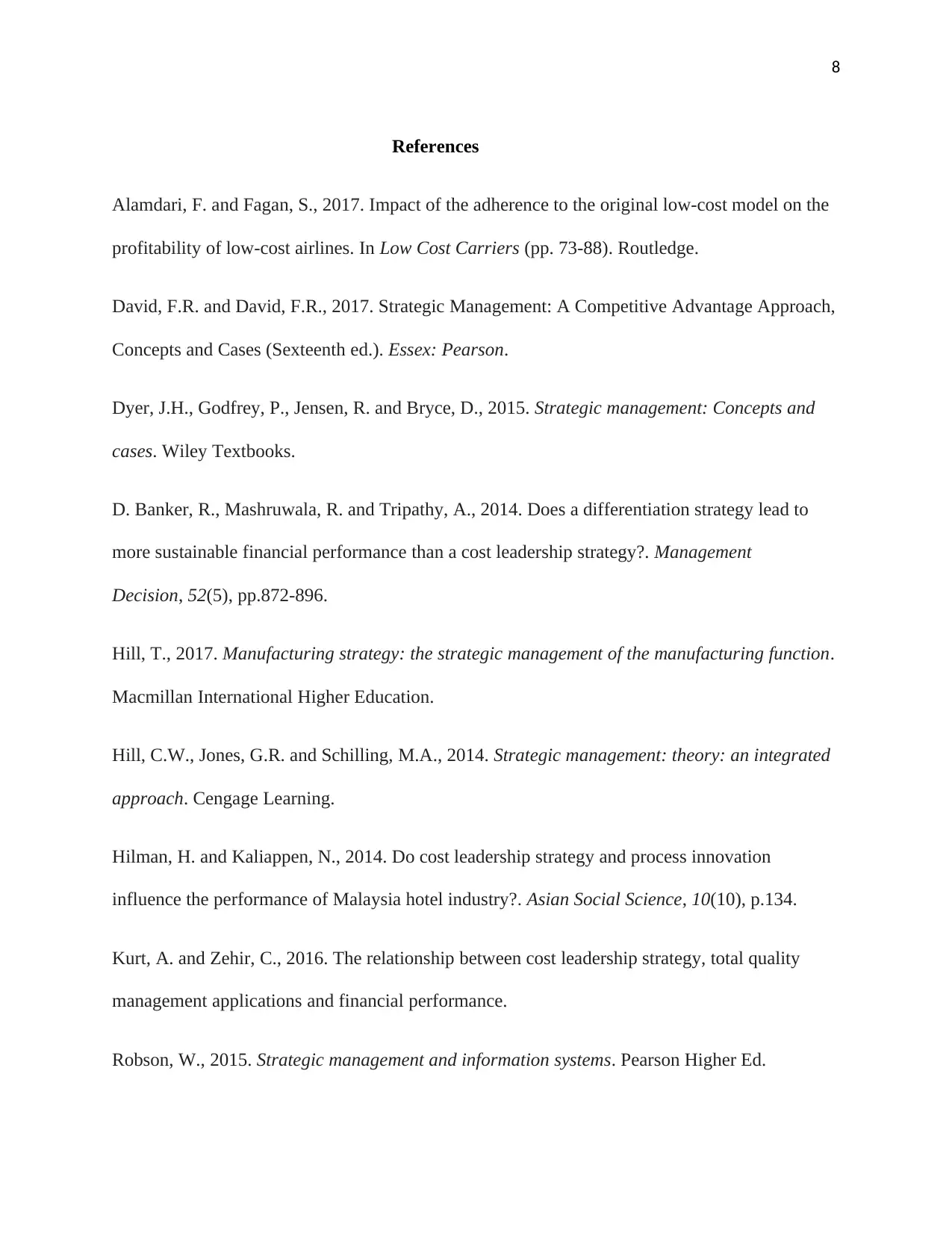
8
References
Alamdari, F. and Fagan, S., 2017. Impact of the adherence to the original low-cost model on the
profitability of low-cost airlines. In Low Cost Carriers (pp. 73-88). Routledge.
David, F.R. and David, F.R., 2017. Strategic Management: A Competitive Advantage Approach,
Concepts and Cases (Sexteenth ed.). Essex: Pearson.
Dyer, J.H., Godfrey, P., Jensen, R. and Bryce, D., 2015. Strategic management: Concepts and
cases. Wiley Textbooks.
D. Banker, R., Mashruwala, R. and Tripathy, A., 2014. Does a differentiation strategy lead to
more sustainable financial performance than a cost leadership strategy?. Management
Decision, 52(5), pp.872-896.
Hill, T., 2017. Manufacturing strategy: the strategic management of the manufacturing function.
Macmillan International Higher Education.
Hill, C.W., Jones, G.R. and Schilling, M.A., 2014. Strategic management: theory: an integrated
approach. Cengage Learning.
Hilman, H. and Kaliappen, N., 2014. Do cost leadership strategy and process innovation
influence the performance of Malaysia hotel industry?. Asian Social Science, 10(10), p.134.
Kurt, A. and Zehir, C., 2016. The relationship between cost leadership strategy, total quality
management applications and financial performance.
Robson, W., 2015. Strategic management and information systems. Pearson Higher Ed.
References
Alamdari, F. and Fagan, S., 2017. Impact of the adherence to the original low-cost model on the
profitability of low-cost airlines. In Low Cost Carriers (pp. 73-88). Routledge.
David, F.R. and David, F.R., 2017. Strategic Management: A Competitive Advantage Approach,
Concepts and Cases (Sexteenth ed.). Essex: Pearson.
Dyer, J.H., Godfrey, P., Jensen, R. and Bryce, D., 2015. Strategic management: Concepts and
cases. Wiley Textbooks.
D. Banker, R., Mashruwala, R. and Tripathy, A., 2014. Does a differentiation strategy lead to
more sustainable financial performance than a cost leadership strategy?. Management
Decision, 52(5), pp.872-896.
Hill, T., 2017. Manufacturing strategy: the strategic management of the manufacturing function.
Macmillan International Higher Education.
Hill, C.W., Jones, G.R. and Schilling, M.A., 2014. Strategic management: theory: an integrated
approach. Cengage Learning.
Hilman, H. and Kaliappen, N., 2014. Do cost leadership strategy and process innovation
influence the performance of Malaysia hotel industry?. Asian Social Science, 10(10), p.134.
Kurt, A. and Zehir, C., 2016. The relationship between cost leadership strategy, total quality
management applications and financial performance.
Robson, W., 2015. Strategic management and information systems. Pearson Higher Ed.
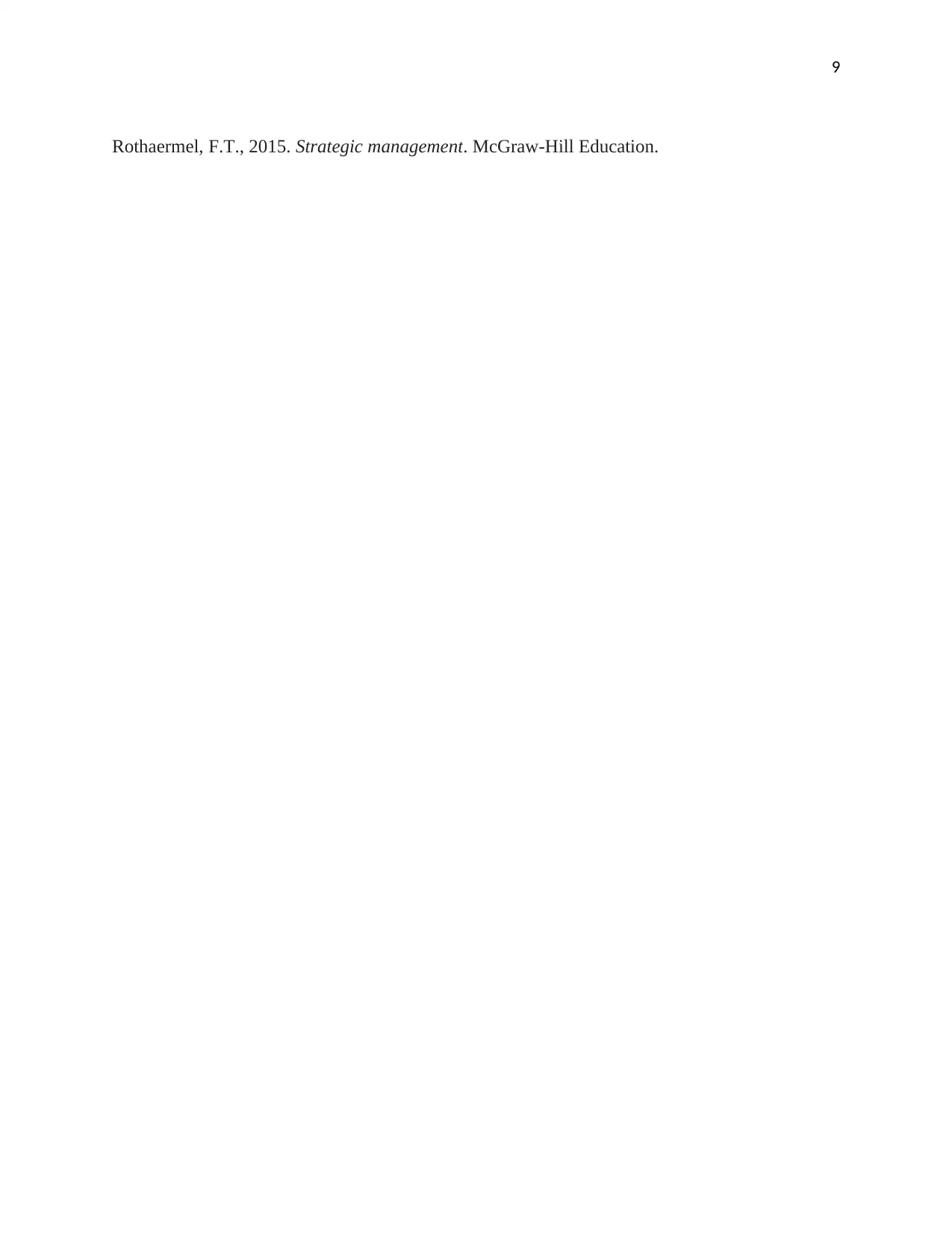
9
Rothaermel, F.T., 2015. Strategic management. McGraw-Hill Education.
Rothaermel, F.T., 2015. Strategic management. McGraw-Hill Education.
⊘ This is a preview!⊘
Do you want full access?
Subscribe today to unlock all pages.

Trusted by 1+ million students worldwide
1 out of 9
Related Documents
Your All-in-One AI-Powered Toolkit for Academic Success.
+13062052269
info@desklib.com
Available 24*7 on WhatsApp / Email
![[object Object]](/_next/static/media/star-bottom.7253800d.svg)
Unlock your academic potential
Copyright © 2020–2025 A2Z Services. All Rights Reserved. Developed and managed by ZUCOL.




